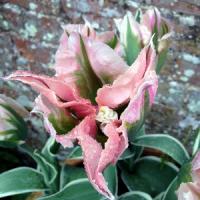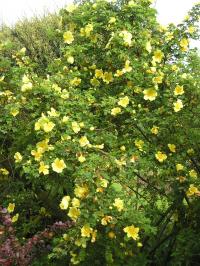Episode 33: Gardening Jobs & Our Plant of the Month for May

Our plant of the month; Rosa xanthina 'Canary Bird' and jobs to do in the garden for May.
Download: Episode 33: Gardening Jobs & Our Plant of the Month for May
File Size: 7.8 MB, Duration: 16' 35"
May is probably one of the best months in the garden. While all of the seasons in the garden have something to offer, late spring has to be one of the better ones.
The weather is not too hot and there is usually sufficient rainfall, the perfect combination for optimum growing conditions. But with perfect growing conditions comes lots of hard work. There is definitely lots to do for the keen gardener this month, and the weeds in particular seem to grow faster than the cultivated plants at this time of year!
Plant of the Month

Our plant of the month for May is Rosa xanthina 'Canary Bird' - Canary Bird Rose
- Deciduous, perennial shrub-rose
- Spreading habit, suitable for hedging
- Fully hardy, RHS H7 hardy in the severest European continental climates (< -20C)
- Height up to 2.5m, spread 3m
- Full sun or partial shade
- RHS Award of Garden Merit
- Growth Rate: Average, 2-5 years to maturity
- Flowers: Single, bright yellow flowers 5cm diameter on arching stems, lightly fragrant, from April to May. Often a second flush of flowers in late summer.
- Foliage: Smallish, fern-like mid green leaves
- Soil: Moist, but well drained soil, fertile, humus rich. Will tolerate poorer soil
- Propagate: Take hardwood cuttings in autumn, or propagate by budding in summer
- Maintenance: Apply mulch of well rotted garden compost or manure in late winter or early spring
- Pests and Diseases: Black spot, rose rust and powdery mildew. Aphids, leafhoppers, scale insects and caterpillars.
Jobs in the Garden
- Dead-heading
- Removing the spent flowers from most flowering plants prevents the onset of seed production and encourages the development of more flowers.
- A combination of dead-heading and regular feeding can significantly extend the flowering period of many plants.
- Fill containers and hanging baskets for the summer
- A damaging frost is highly unlikely this month so it is time to plant out summer containers and hanging baskets.
- The trick is to leave small but unnoticeable gaps between the plants in the container or hanging basket when planting, making them look full from the start. But at the same time, leave enough space between plants so that there is space in the compost for the roots to grow into.
- Use good quality compost that will retain moisture for as long as possible.
- Stake perennial plants
- Begin to stake perennial plants that you know will need support in a few weeks time e.g. Delphiniums.
- Purpose designed stakes and props are available or you can just use a bamboo cane surround and garden twine.
- Lawns
- Apply a lawn weed and feed treatment if you have not already done so this year and consider using an organic lawn feed if you can.
- Such feeds help the grass to grow vigorously and compete strongly against weeds.
- Organic lawn treatments are also earthworm friendly, whereas chemical treatments can kill earthworms, which can result in poor lawn drainage.
- Sow seeds of hardy biennials in-situ e.g. Foxgloves, Sweet williams
- Plant out Dahlia tubers after overwintering
- Trim evergreen hedges e.g. Box, Yew
- Continue to spray roses that are prone to attack from blackspot and greenfly
- Water new plantings if the weather is dry
- Prune shrubs that have just finished flowering e.g. Forsythia and Ribes
- If a very late frost is forecast cover all tender plants including those in the vegetable garden with horticultural fleece
In the Vegetable Garden
- Sow outside: Peas, Runner beans, Marrows, Courgettes, Pumpkins, Carrots, Turnips, Swedes, Potato tubers, Kale, Calabrese, Broccoli, Cauliflower, Cabbage and Beetroot
- Plant out young plants that have been started indoors of: Sweetcorn, Runner beans, Tomatoes, Aubergines, Peppers, Marrows, Courgettes, Cucumbers, Melons and Pumpkins
- Harvest: Asparagus, Rhubarb and Spinach
Forthcoming Garden and Flower Shows
Useful Links
.



